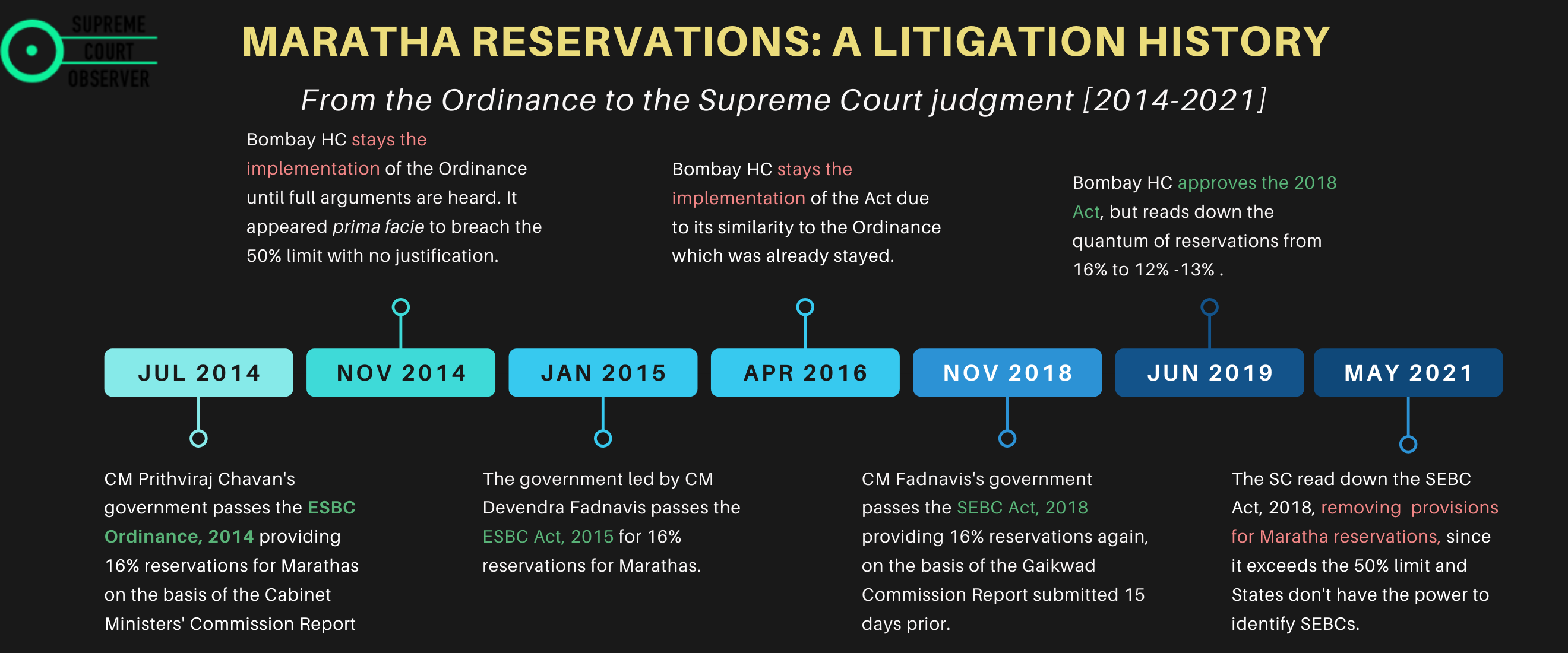Analysis
The Marathas’ Demand for Reservation: A Litigation History [2014-21]
The Court has struck down reservation for Marathas, after 3 attempts in the 4th round of litigation on the issue. Will there be Attempt 4?

Marathas had organised for reservation demands even as far back as 1982, when Annasaheb Patil had taken his life in protest. However, those were for reservations on the basis of economic backwardness The demand for Maratha reservation on a caste-basis began after the Mandal Commission. In 1997, The Maratha Sangh and the Maratha Seva Sangh had held one of the first large-scale demonstrations for the demand. By 2009, even former Chief Ministers Sharad Pawar and Vilasrao Deshmukh had lent support to the cause.
ESBC Ordinance, Act 2014: Stayed by the Bombay High Court
In 2013, CM Prithviraj Chavan constituted a committee headed by Cabinet Minister Narayan Rane. They conducted a survey and concluded that Marathas were a backward class. The earlier national and state surveys had opposite findings. On July 9th 2014, the Governor was advised to pass the Maharashtra State Reservation for Educationally and Socially Backward Category (ESBC) Ordinance, 2014. It granted 16% reservation for Marathas in public employment and higher education. Five percent was also reserved for some Muslim communities based on a 2013 report by the Dr. Mehmood-ur-Rahman Committee.
The ordinance was immediately challenged at the Bombay High Court. The petitioners argued it exceeded the 50% ceiling on reservations set by the Supreme Court in Indra Sawhney v Union of India. And failed to provide quantitative data indicating backwardness. In its interim order on November 14th 2014, the Court partially stayed the Ordinance, until full arguments could be heard. Maharashtra already had reservations of 52%.
During these proceedings, State Assembly elections had replaced the government. The new Government, now led by CM Devendra Fadnavis, acted promptly. On January 9th 2015, the Ordinance was passed as an Act. However, the provision for Muslim communities was dropped. In April 2016, the Bombay High Court stayed the Act for its resemblance to the Ordinance.
SEBC Act 2018 Upheld by the Bombay High Court
The Government then constituted a statutory commission to look into the issue. The Maharashtra State Backward Classes Commission (MSBCC), formed under an Act of 2005 of the same name, was asked to conduct a survey. It was led by retired Bombay High Court Judge N.G. Gaikwad. It submitted a report on November 15th 2018. The report recommended reservation of 12% in higher education and 13% in public employment. Promptly once again, on November 30th, the Maharashtra State Reservation for Socially and Educationally Backward Classes (SEBC) Act, 2018 was made law. However, it provided for 16% reservations overall.
Meanwhile, on August 11th 2018, Parliament had passed the 102nd Constitutional (Amendment) Act, 2018. This Act sought to provide constitutional status to the National Commission for Backward Classes. In doing so, however, it also introduced Article 324A. This Article created a provision for the President to notify a ‘Central List’ of SEBCs. When the SEBC Act, 2018 was challenged at the Bombay High Court, a new argument was introduced. The petitioners also argued that the new Article 342A took away States’ powers to identify SEBCs. And so, they could not identify new communities such as the Marathas for reservation.
The Court heard the case for around 40 days and upheld the Act on June 27th 2019. It held that the Gaikwad Commission Report had sufficient data to justify ‘extraordinary circumstances’ as an exception to the 50% limit on reservations. It also held that the 102nd Amendment did not affect States’ powers to identify SEBCs. However, the Court reduced the the amount of reservations from 16% to 12% and 13%, as recommended by the Gaikwad Commission. The Maharashtra government amended the Act accordingly.
SEBC Act 2018, As Amended: Appeal Admitted by the Supreme Court
The judgment was appealed. On 12 July 2019, notice was issued and arguments heard on admitting the case. Since the matter had come before the Apex Court, the State of Maharashtra introduced a new argument. They sought to argue that the 50% limit itself should be revisited. The rule was laid down in a judgment of the Supreme Court and hence the same Court could reconsider it if there were compelling reasons.
A bench consisting of Justices Nageswara Rao, Hemant Gupta and Ravindra Bhat heard preliminary arguments. In its order on 9 September 2020, considering the substantial questions of law regarding the 50% limit and the interpretation of the new Article 342A, they decided to refer the case to a larger bench. They also stayed the implementation of the Act until the matter was heard. In 2019, the Maharashtra government had changed once more, now led by CM Uddhav Thackeray. However, their position had not changed.
The Supreme Court Reads Down the SEBC Act in 2021
A Constitution Bench was set up with the above three judges and Justices Ashok Bhushan and Abdul Nazeer. Since the legal issues would affect all States, all of them were issued notice and made submissions. After 10 days of virtual hearings through the pandemic, the Bench pronounced a judgment on May 5th. It upheld the 50% rule. And finding that Marathas were politically dominant, it held that there was no justified exception to breach the limit. Further, in a 3:2 split it held that the 102nd Amendment did take away States’ powers to identify SEBCs.
Following the verdict, CM Thackeray requested the Prime Minister and President to provide for Maratha reservations. The Central Government has already filed a review petition. They have sought to revisit the Court’s interpretation of the 102nd Amendment in particular. This verdict has now left not just one, but two legal hurdles to granting Maratha reservation.